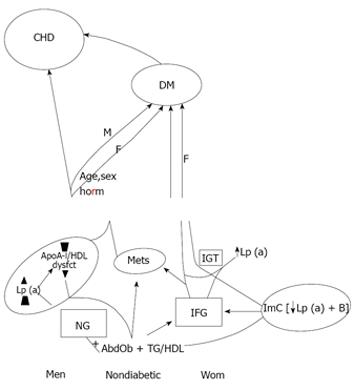Copyright
©2013 Baishideng Publishing Group Co.
World J Diabetes. Oct 15, 2013; 4(5): 210-218
Published online Oct 15, 2013. doi: 10.4239/wjd.v4.i5.210
Published online Oct 15, 2013. doi: 10.4239/wjd.v4.i5.210
Figure 1 Schematic illustration.
Schematic illustration of major pathways derived from the current study leading from normoglycemia (NG)/impaired fasting glucose (IFG) to metabolic syndrome (MetS), diabetes (DM) and coronary heart disease (CHD) in non-diabetic men and women. Abdominal obesity and components of atherogenic dyslipidemia, the core of MetS, added to excess lipoprotein (Lp) (a), dysfunction of apoA-I and high-density lipoprotein (HDL) particles, commonly associated with normoglycemia rather than IFG, are major primary determinants of cardiometabolic risk, especially in men. Women often exhibit the added factor of lower assayable Lp (a) due to immune complex formation (ImC) which may lead from IFG via impaired glucose tolerance (IGT) to new-onset and established diabetes or via MetS to diabetes and, in turn, to CHD, contributed by menopause and alterations in sex hormones.
- Citation: Onat A, Aydın M, Can G, Çakmak HA, Köroğlu B, Kaya A, Ademoğlu E. Impaired fasting glucose: Pro-diabetic, “atheroprotective” and modified by metabolic syndrome. World J Diabetes 2013; 4(5): 210-218
- URL: https://www.wjgnet.com/1948-9358/full/v4/i5/210.htm
- DOI: https://dx.doi.org/10.4239/wjd.v4.i5.210









